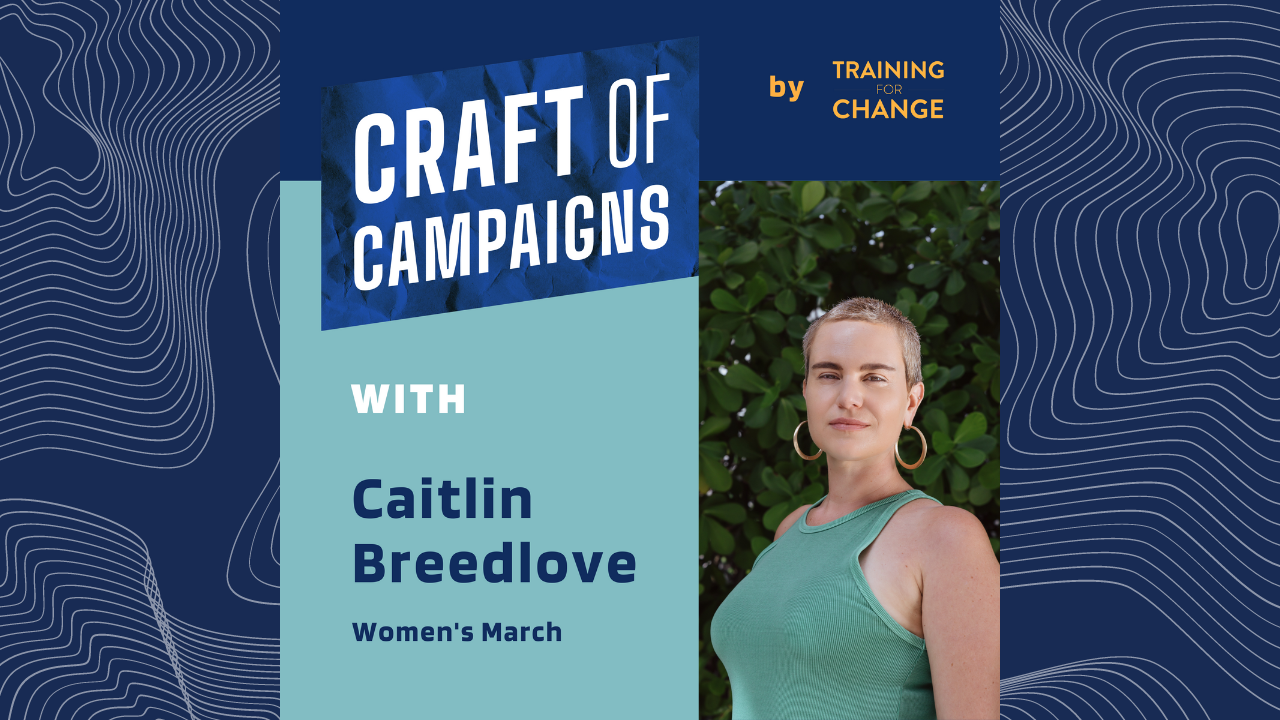The Craft of Campaigns podcast highlights stories and lessons from issue-based action campaigns beyond one-off mobilizations and single election cycles. Campaigns channel grassroots energy to win concrete victories, build winning coalitions, and topple pillars of power standing in the way of justice. In each episode, we interview organizers about how a campaign unfolded, the strategy decisions they made, and the lessons we can draw for our current moment.
For this Craft of Campaigns podcast, I talked with Caitlin Breedlove of Women’s March. You can read the writeup below or check out the full episode here or at Apple Podcasts, Spotify or wherever you get your podcasts.
Back in March 2020, while shopping at a Phoenix Walmart, Women’s March deputy executive director Caitlin Breedlove noticed a group of women in front of an empty product display. The shelf had once held products like diapers and baby wipes — essentials that had become challenging to find in the early days of the pandemic. Many of the women commented that they would have to look for the items on Amazon. But Women’s March organizers soon learned that Amazon was allowing third-party distributors to jack up the prices on those products. So the Women’s March — along with groups of Amazon workers and other organizations interested in corporate accountability — launched a seven-day campaign to convince the company to cap prices on essentials. Within days of launching an online petition demanding that Amazon stop “pandemic profiteering,” the company agreed to institute price caps. According to Caitlin, that’s not always how it goes. “We’re usually testing quickly for the appetite from our base” – the several million people who have taken online actions and the hundreds of thousands who have participated in marches – and often we’ll be interested in something, and it falls flat quickly. In this case, there was interest from the base, it aligned with our values and goals, and we were able to win quickly because it would be unpopular for Amazon not to respond given the tone and tenor at the time.” The company was also put on the hot seat by Sen. Ed Markey and other elected officials around the same time.
But the point was not just to change conditions for women (and anyone who needs diapers), but to change how everyday people see themselves. To Women’s March, it’s not just about “getting a win” — they design campaigns to welcome people on a journey. “I was trained up understanding campaigns as, you get the light fixed, then can we convince City Council to get the cops out of schools,” Catilin told me. “Those kinds of campaigns where there’s an arc, you were building community power, and you were able to achieve that. I think those kinds of grassroots community campaigns are incredibly powerful. But the issue becomes when we’re thinking about engaging on a national level, [we shouldn’t assume] that very small groups of people will be able to engage huge groups of people. [Other organizations work] with a smaller group of people very, very deeply and then those leaders go out to engage people in other locations. At Women’s March, what we’re doing is testing what’s important to people at a large scale and seeing what aligns with our values, and if folks pick that up, we move on those campaign ideas. It’s a very different way of engaging folks.”
Most organizations think about the strategic value of campaigns in terms of the organizing flywheel: each element leads to and is dependent on the other. You can’t build a base without developing your members into member leaders; you can’t develop member leaders without campaigns to train them; you can’t build campaigns without a clear base to mobilize. But Caitlin argues that it’s possible for an organization to emphasize just one part of the flywheel rather than all of them. And rather than using campaigns to recruit dues-paying members, Women’s March uses them to welcome people into activism.
“There’s a lot of conversations right now about, ‘What does membership mean now in organizing?’, which implies bringing people in, training, retaining them. But another conversation is, ‘How do we think about mass-scale political identity development and literally just welcoming people into the movement?’ It’s like my colleague Tamika Middleton said, ‘You can’t show much more openness to engagement than with a sign and a sharpie.’ The first Women’s March was a spontaneous action [in response to Donald Trump’s election] that a container was built around,” she said. “Eighty-five percent of our marchers are marching for the first time with Women’s March. From a membership-based understanding, that’s terrible, there’s almost no retention there at all. We’re not retaining a base. But we are not in the change business of retention, we’re in the change business of political identity formation, and that means that we’re often the welcome mat and the on-ramp and those folks go elsewhere.” Caitlin also cites the five-hundred-plus local marches around the country and 20,000 women traveling annually to marches in DC, five years after the original march. ,
This approach complements the ways base building organizations approach campaigns, such as recruiting new members who get funneled into leadership programs or mobilizing existing members to win specific policy demands. The Women’s March approach, as Caitlin describes it, is to use campaigns to activate people who might become involved as active participants affiliated primarily with other membership-based organizations. “If they’re really interested in corporate accountability and feminism, they might go to Ultraviolet. If they’re really interested in Black feminist organizing, they might go to Black Feminist Future. They might go to Color Of Change, they may get involved with ACLU, they may go to Greenpeace, they might also go to their local grassroots organizations.” She added that some Indivisible chapters grew out of local Women’s Marches, and some of the group’s members have used their Women’s March participation as launching pads for their electoral campaigns.
Check out my conversation with Caitlin for more on how Women’s March thinks about building accessible containers for organizing and makes sure their recruits don’t hear the message that “us ten thousand Navy SEALS of the Left have this handled” after they get involved in one of the group’s campaigns.

